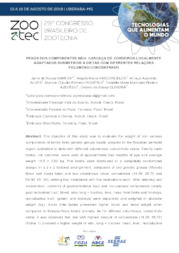Pesos dos componentes não-carcaça de cordeiros localmente adaptados submetidos a dietas com diferentes relações volumoso:concentrado.
Pesos dos componentes não-carcaça de cordeiros localmente adaptados submetidos a dietas com diferentes relações volumoso:concentrado.
Autoria: SANTOS, J. de S.; VASCONCELOS, A. M.; ALVES, A. A.; ROGERIO, M. C. P.; AZEVEDO, D. M. M. R.; OLIVEIRA, D. de S.
Resumo: Abstract: The objective of this study was to evaluate the weight of non carcass components of lambs from genetic groups locally adapted to the Brazilian semiarid region submitted to diets with different voluminous: concentrate ratios. Twenty male lambs, not castrated, were used at approximately four months of age and average weight 18.8 ± 2.82 kg. The lambs were distributed in a completely randomized design, in a 2 x 2 factorial arrangement, composed of two genetic groups (Morada Nova and Santa Inês) and two voluminous ratios: concentrate (14.28: 85.72 and 54.96: 45, 04), making four treatments with five replications each. After skinning and evisceration, contents of gastrointestinal tract and non-carcass components (empty gastrointestinal tract, blood, skin, lung + trachea, liver, head, hind limbs and forelegs, reproductive tract, spleen and kidneys) were separated and weighed in absolute weight (kg). Santa Inês lambs presented higher blood and head weight when compared to Morada Nova breed animals. As for different voluminous: concentrate ratios, it was observed that diet with highest amount of concentrate (14.28: 85.72) (Table 1) provided a higher weight of skin, lung + trachea, heart, liver, reproductive system and spleen . Diets with lower bulk ratio: concentrate (14,28: 85,72) promote better weights of non-carcass components of lambs from genetic groups locally adapted to Brazilian semiarid.
Ano de publicação: 2019
Tipo de publicação: Artigo em anais e proceedings
Unidade: Embrapa Caprinos e Ovinos
Palavras-chave: Alimento Concentrado, Brasil, Brazilian semiarid, Carcaça, Carne ovina, Cordeiro, Nutrição Animal, Ovino, Ovino de corte, Peso, Raça Morada Nova, Raça Santa Inês, Semiárido, Volumosos, Víscera
Observações
1 - Por padrão são exibidas publicações dos últimos 20 anos. Para encontrar publicações mais antigas, configure o filtro ano de publicação, colocando o ano a partir do qual você deseja encontrar publicações. O filtro está na coluna da esquerda na busca acima.
2 - Para ler algumas publicações da Embrapa (apenas as que estão em formato ePub), é necessário ter, no celular ou computador, um desses softwares gratuitos. Sistemas Android: Google Play Livros; IOS: iBooks; Windows e Linux: software Calibre.
Acesse outras publicações
Acesse a Base de Dados da Pesquisa Agropecuária (BDPA) para consultar o acervo completo das bibliotecas da Embrapa.

